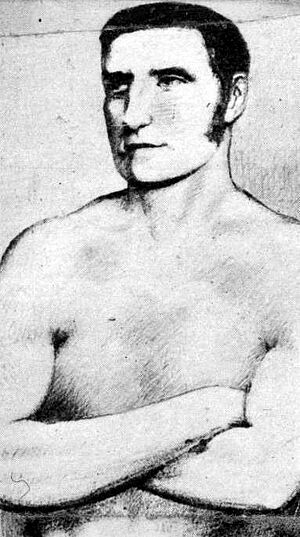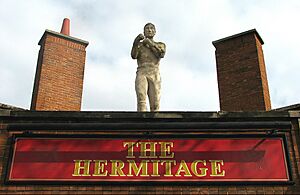William Thompson (boxer) facts for kids
Quick facts for kids William Thompson |
|
|---|---|
 |
|
| Statistics | |
| Nickname(s) | Bendigo, Bendego (in period newspapers) |
| Rated at | averaged 165 lb (75 kg), weight range 164 to 168 pounds (74–76 kg) |
| Height | 5 ft 9.75 in (1.77 m) |
| Born | 11 October 1811 Trinity Walk, Nottingham, England |
| Died | 23 August 1880 (aged 68) Beeston, Nottinghamshire, England |
| Stance | Southpaw Used London Prize Ring Rules after 1838 |
| Boxing record | |
| Total fights | 20 |
| Wins | 19 |
William Abednego Thompson (born October 11, 1811 – died August 23, 1880) was a famous English bare-knuckle boxer. He was also known as Bendigo Thompson. He became the heavyweight champion of England on February 12, 1839.
Thompson is highly respected in boxing history. He was added to The Ring magazine Hall of Fame in 1955. Later, he joined the International Boxing Hall of Fame in 1991. In 2011, he was honored in the Bare Knuckle Boxing Hall of Fame. His unique nickname, "Bendigo," even inspired the name of a city and creek in Australia.
Contents
Who Was William Thompson?
Early Life and Family
William Thompson was born in Nottingham, England, on October 11, 1811. He was one of six or seven children. When he was 15, his father passed away. William and his mother had to go to the Nottingham Workhouse, a place where poor people lived and worked.
After leaving the workhouse, William sold oysters on the streets. He then got a job as an iron turner. This work helped him build his strong muscles.
Becoming a Boxer
By age 18, Thompson started fighting to help his family. He won his first eight fights, including against the champion of a nearby town. At 21, he became a professional prize fighter.
Thompson was a southpaw, meaning he fought with his left hand forward. People said he could punch very hard and fast. He was also very quick and agile. He earned the nickname "Bendy" because he would bob and weave a lot in the ring. This nickname, combined with his middle name Abednego, became "Bendigo."
His speed and agility helped him win fights. But his fun personality and sense of humor made him a favorite with the crowds.
Thompson's Boxing Career
First Fight Against Ben Caunt
Thompson had a big rivalry with another boxer named Ben Caunt. Their first fight was on July 21, 1835. It lasted 35 minutes and had 22 rounds. In the last round, Caunt hit Thompson while Thompson was sitting in his corner. This was against the rules, so Caunt lost the match because of a foul.
Over the next two years, Thompson won three more fights. He beat John Leachman in 52 rounds and Charley Langham in 51 rounds. He also defeated William Looney in a long fight that lasted 92 rounds.
Becoming Champion of England
Thompson's fame grew steadily. On April 3, 1838, he had a rematch with Ben Caunt. Thompson was in better shape and had more speed. The fight lasted 75 rounds. The referee stopped the fight because Thompson fell without being hit, which was against the London Prize Ring Rules. Thompson said it was a slip, and many agreed he was winning easily. After the fight, there was a lot of chaos among the fans.
On February 8, 1839, when Thompson was 28, he fought James "Deaf" Burke for the All England Title. This was one of his first fights under the new London Prize Ring Rules. Burke lost on a foul after only ten rounds. This made Thompson the "Nottingham Jester," Champion Prize Fighter Of All England!
A few weeks later, he received his Champion's Belt. When he returned to Nottingham, he celebrated by doing a somersault. He accidentally hurt his kneecap and couldn't fight for two years. After he recovered, he won 19 more fights over the next four years.
Defending His Title Against Caunt
On September 9, 1845, Thompson and Caunt met for their third and final fight. About 11,000 people came to watch. Thompson used tactics like crouching and bobbing to make it hard for Caunt to hit him. The fight lasted 93 rounds, over two hours! Caunt eventually sat down without being hit, which was a foul. Thompson won the fight, even though Caunt was taller, heavier, and younger. This fight was known for many fouls from both boxers.
After this tough fight, Thompson took a break from boxing. He enjoyed fishing and even won several awards for it.
Last Title Fight with Tom Paddock
Even though he was enjoying a quiet life, Thompson accepted one last challenge. On June 5, 1850, at 39 years old, he fought young Tom Paddock. His 82-year-old mother encouraged him, saying he would be a coward if he didn't fight.
The fight was very close and lasted over an hour. In the final round, Thompson's corner called a foul, and the referee agreed. Thompson won his last fight.
Life After Boxing
Thompson, "The Nottingham Jester," retired as an undefeated champion. He had two prize belts and four silver cups. His strong personality and amazing record made him very popular. Even famous writer Sir Arthur Conan Doyle was a fan.
Thompson proudly said, "I was engaged in 21 matched fights and never was beaten in one." After retiring, he became an unofficial boxing coach at Oxford University. This was a big step up from his earlier life in the workhouse.
He later returned to Nottingham. He became involved with a group called the Nottingham Lambs. This group protested against poor living conditions and sometimes caused unrest.
Later Years and Legacy
Thompson moved to Beeston. Once, at age 59, he saved three people from drowning in a river. When offered a reward, he refused, reminding them he was the champion of England.
In 1872, Thompson started giving sermons. Even though he couldn't read, he spoke powerfully. He would often take a boxer's stance and point to his trophies, saying, "See them belts? See them cups? I used to fight for those, but now I fight for Christ." Thousands came to hear him speak.
Thompson passed away on August 23, 1880, at age 68, after falling down stairs at his home. Thousands of people lined the streets for his funeral. Even The Times newspaper in London published an obituary for him, which was a great honor. He was buried in Nottingham. His tomb, which has a crouching lion, can still be seen today.
Selected Fights
| 5 Wins, 1 Loss | |||||||
| Result | Opponent(s) | Date | Location | Duration | Notes | ||
| Win | Joe Hanley | Oct 1832 | England | 16 rounds | |||
| Win | Ben Caunt | 21 June 1835 | Nottingham England | 22 Rounds | Won on a foul, Caunt struck Thompson when he was down | ||
| Win | Bill Looney | 13 June 1837 | Chapel-en-le-Firth, England | 99 Rounds | |||
| Loss | Ben Caunt | 3 April 1838 | Shelby, England | 75 rounds | Lost on foul | ||
| Win | James Burke | 12 February 1839 | Heather, England | 10 rounds | Won Championship of England, on foul | ||
| Win | Ben Caunt | 9 September 1845 | Stoney Stratford, England | 75 rounds | Defended English Championship, won on foul | ||
| Win | Ben Caunt | 5 June 1850 | Mildenhall, England | 75 rounds | Retained English Champion, won on foul, then retired | ||
Bendigo's Lasting Impact

Thompson's legacy lives on in many ways. A pub in Nottingham was named "Bendigo's" after him. Even though it's now closed, locals still call the building "Bendigo's."
A police area in Nottingham is called Bendigo. There's also a small housing area with a main road called Bendigo Lane. One of the trams in Nottingham is named after Bendigo Thompson.
The city of Bendigo in Australia is indirectly named after him. An early Australian shepherd who was also a bare-knuckle boxer had a style like Thompson's. He was given the nickname "Bendigo," which then became the name of a creek and later the city.
In Bestwood, Nottingham, a small nature reserve was known as "Bendigo's Ring." Thompson is also sometimes given credit for introducing the southpaw stance in boxing.
A group in Nottingham called the 'Bendigo Memorial Fund' is raising money for a statue of Bendigo in the city center.
Images for kids




